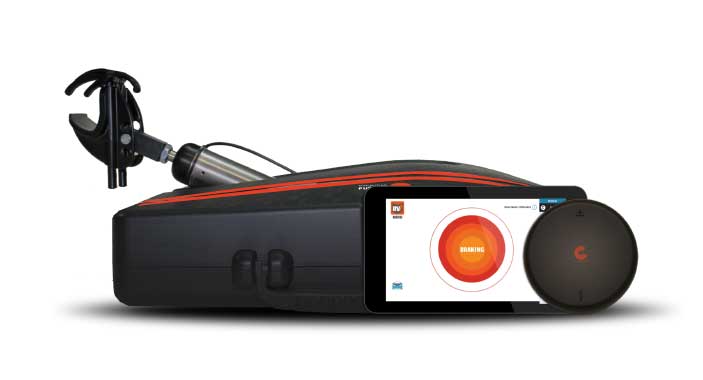Auxiliary braking systems provide safe and legal travel when towing a dinghy vehicle
A dinghy vehicle towed behind a motorhome offers the freedom to travel and park easily when you arrive at your destination, but with that freedom comes responsibility. As previously discussed, a dinghy vehicle is essentially a trailer, and as such, auxiliary braking will dramatically improve towing safety. Part and parcel to this is an auxiliary braking system designed to activate the dinghy vehicle’s brakes when the motorhome’s brakes are applied.

RVibrake3 incorporates inertia-based proportional braking and brake lock detection that prevents damage to the dinghy vehicle’s brake system. The system incorporates the company’s Command Center tablet and hub, designed to make set up, monitoring and other functions clear and easy.
It was once commonplace to find RVers who towed a vehicle behind their motorhome without an auxiliary braking system, their belief being that the motorhome’s system was large and powerful enough to stop both vehicles safely. Adding an auxiliary braking system, however, is the additional “insurance” needed to ensure that braking in emergency situations can be handled safely, even if the motorhome is rated to handle the weight. Today, there is another compelling reason to purchase an auxiliary braking system — it’s the law in 49 states and all provinces in Canada, based on weight (most common) or stopping distance. RVi, which manufactures RVibrake, offers a handy guide to state-by-state towing laws on its website https://rvibrake.com/pages/flat-towing-law that details the requirements.

The Blue Ox Patriot II and Patriot 3 are all-electric portable systems that feature a super capacitor lifetime battery.
Dinghy braking systems can be divided into two classes: portable and permanent. Portable systems are generally more popular because they’re less expensive, easy to install (and remove) and can be transferred between dinghy vehicles. Within the portable brake market are basic systems that are essentially “on/off” devices, and those that offer what is commonly referred to as “proportional braking.” Proportional braking means that the system is designed to mimic the timing and brake application of the motorhome, so as you brake harder, so does the dinghy vehicle. Both devices will get the job done, but proportional systems provide a smoother braking experience than inertia-based systems.

Demco offers the Delta Force portable braking system, as well as the popular Air Force One and Stay-IN-Play Duo permanent systems.
Features in portable systems vary, from ease of installation and set-up to weight/profile, brake application method and more, so shop carefully. Also, keep in mind that most portable systems are powered up by a 12-volt DC port in the dinghy vehicle, which will draw power from its battery. To prevent a drained or dead battery at the end of your journey, it may be necessary to install a charge line kit, which will keep the dinghy battery charged via the motorhome’s electrical system (see November’s Dinghy Digest).

The new Brake Buddy Classic 3 and Select 3 portable brake systems boast a slim profile, convenient carrying handle and adjustable legs that make it easy to compensate for irregular floorboard surfaces.
Sources
Blue Ox | 800-228-9289
Brake Buddy/Hopkins Manufacturing Corp. | 800-470-2287
Demco Products | 800-543-3626
Roadmaster Inc. | 800-669-9690
RVi | 800-815-2159
As the designation would suggest, permanent braking systems are designed for a one-time installation in the dinghy vehicle, and may require a lot of work to transfer from one vehicle to another. Initial installation can also be complex and time consuming, but once in place, permanent systems offer several benefits. First and foremost, set-up is easy — just plug in a power cord and/or quick disconnect and the system is operational. Because they tie into the air- or hydraulic-brake system in the motorhome and/or its electrical system (brake signal) to activate the brakes in the towed vehicle, they are, by nature, proportional.
Finally, they are designed to be practically invisible, typically consisting of a small control unit that mounts underneath the hood or out of view in the passenger compartment (under the dash or seat, for example). Permanent systems are a good choice if you plan to keep the car you’re towing for a while, and you appreciate quick set-up.
With the right auxiliary braking system, you can enjoy the peace of mind that comes with safe (and legal) travel.


